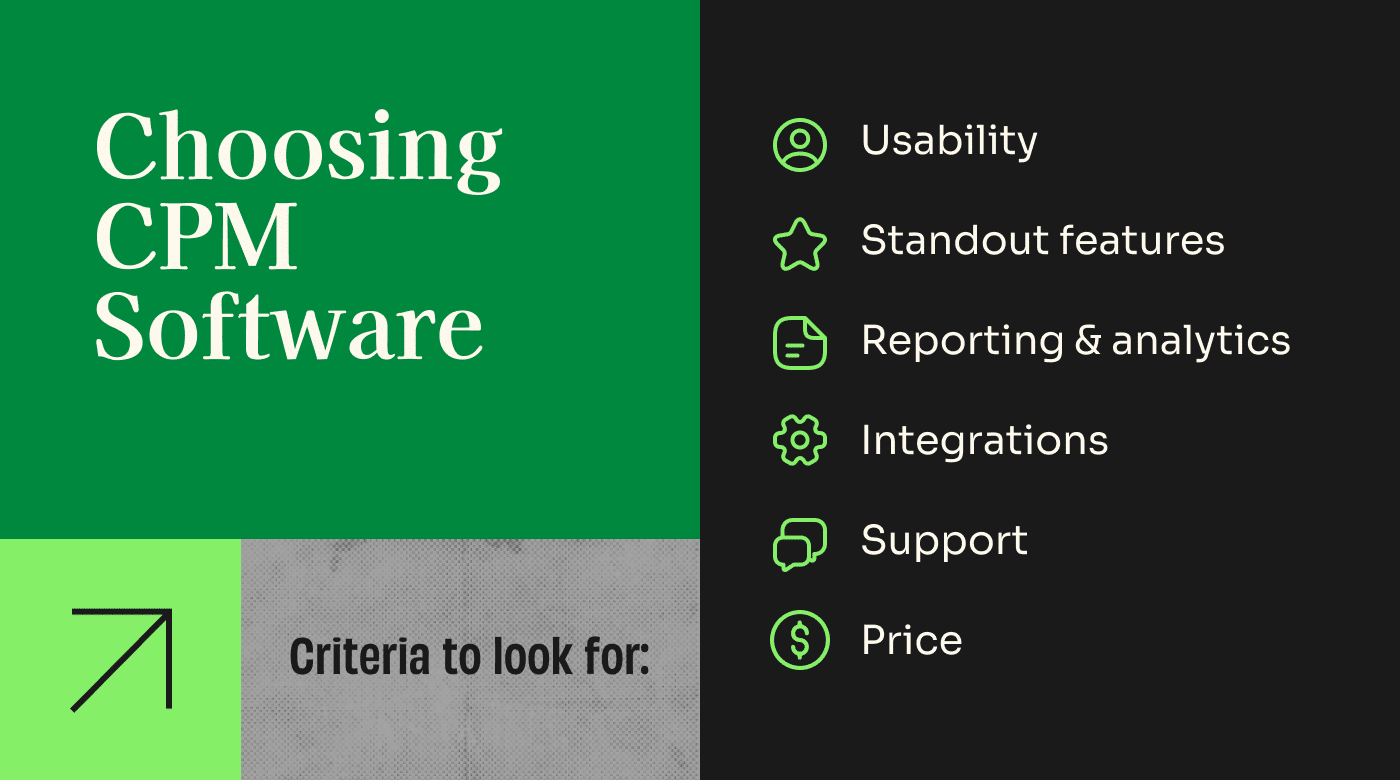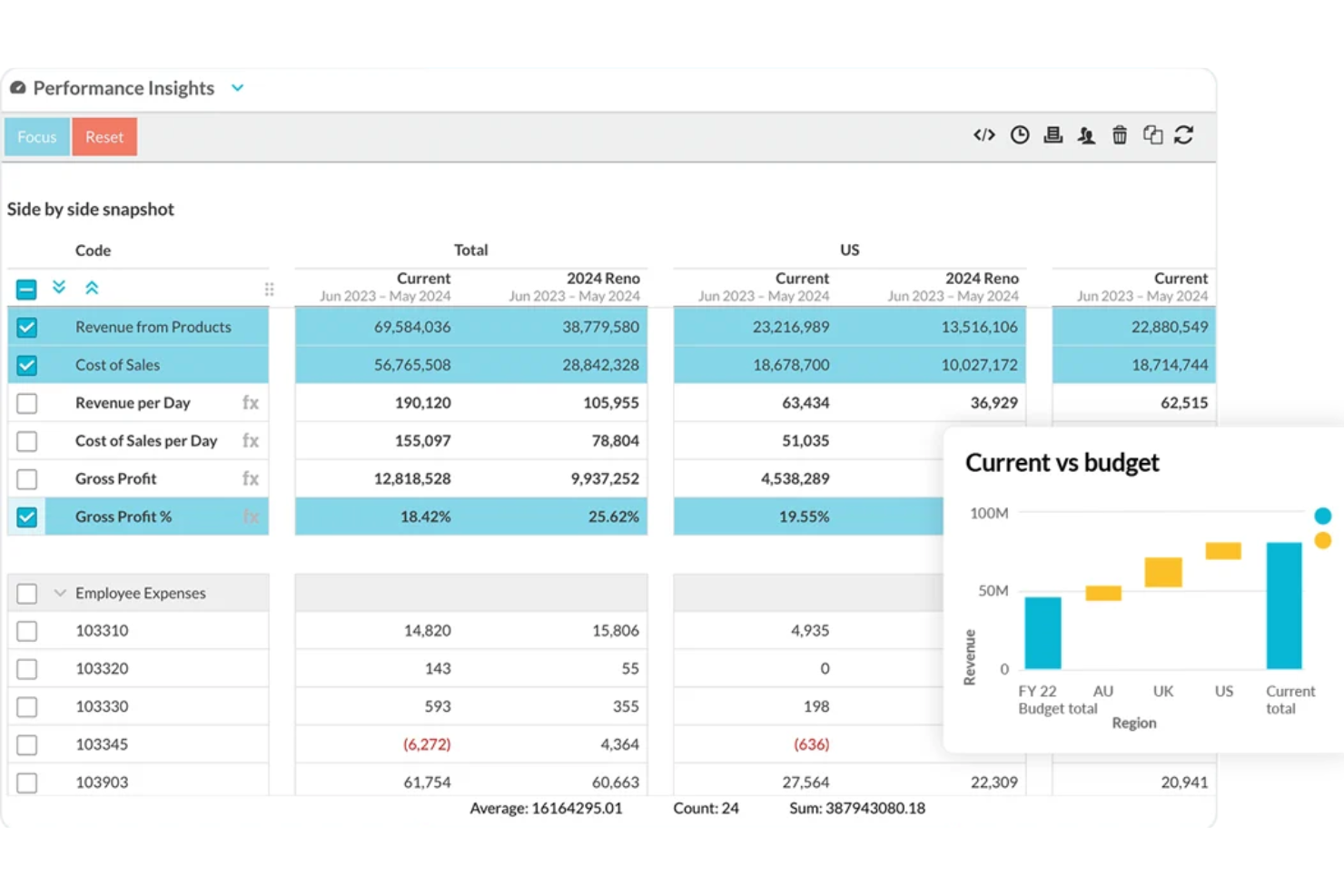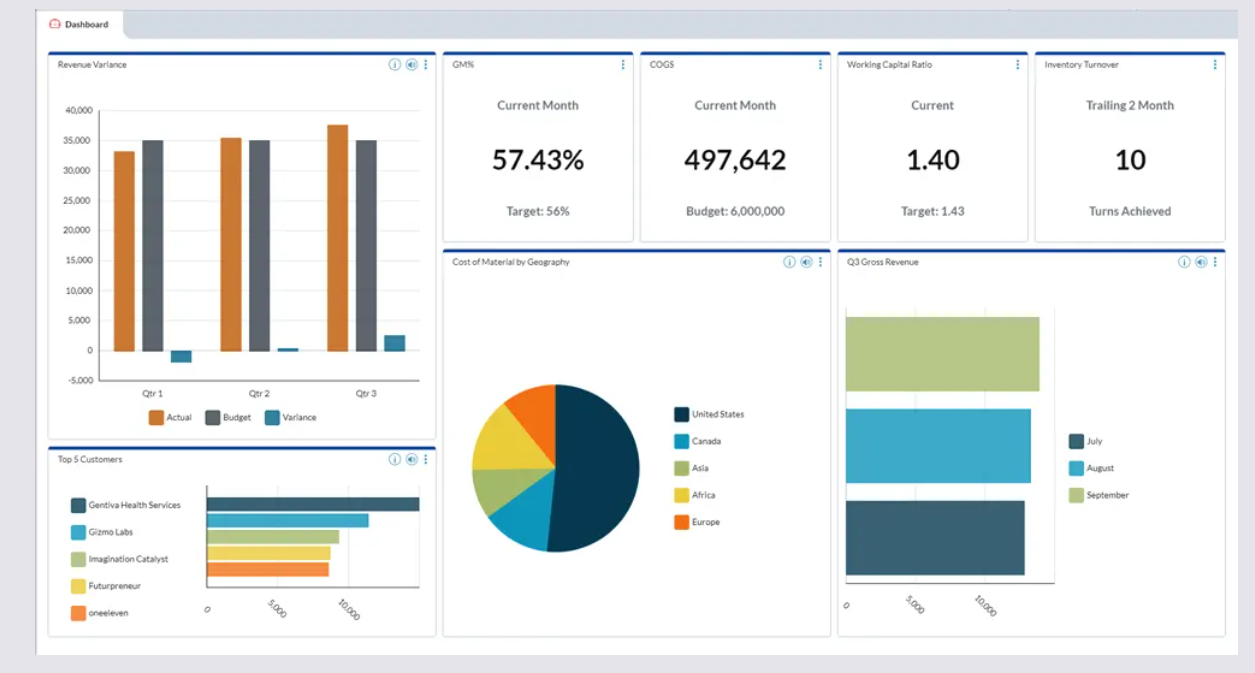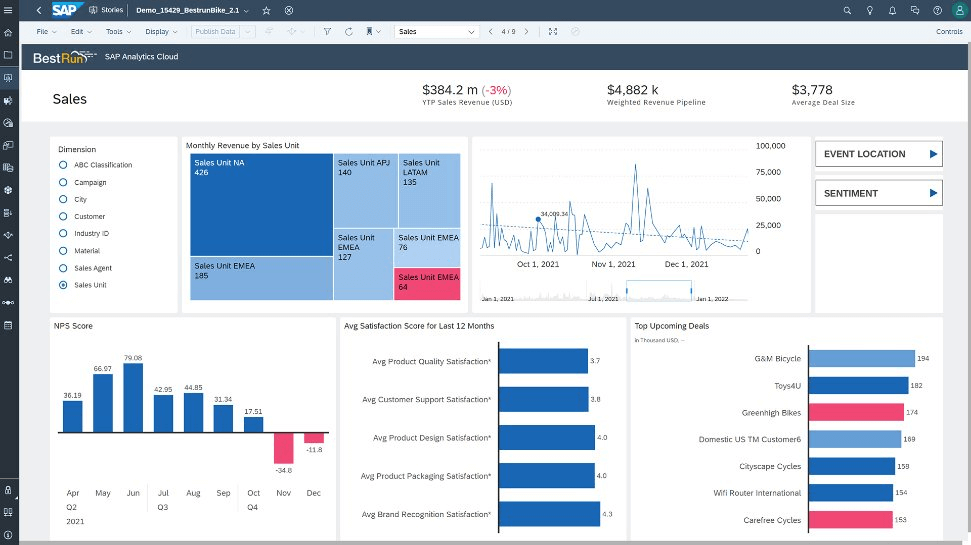10 Best Corporate Performance Management Software Providers Shortlist
Here's my pick of the 10 best software from the 20 tools reviewed.
With so many different CPM solutions available, figuring out which one is right for you is tough. You know you want a unified platform for all financial activities that enables the business to align strategies, track key performance indicators, and make informed decisions, but need to figure out which tool is best. I've got you! In this post I'll help make your choice easy, sharing my personal experiences trying dozens of different tools and information I gathered as a consultant, with my picks of the best corporate performance management software.
What is Corporate Performance Management Software?
Corporate performance management (CPM) software is a comprehensive solution that encompasses a suite of integrated tools that facilitate strategic planning, financial management, and performance analysis, fostering better decision-making and organizational success. It typically includes features such as budgeting and forecasting tools, strategic planning, performance analytics, and financial reporting. These features optimize decision-making processes, enhance collaboration, and provide a comprehensive view of an organization's performance metrics.
Overview Of The Best Corporate Performance Management Software
There are hundreds of CPM solutions on the market. I’ve narrowed it down to the top options based on a combination of factors explained in detail near the end of this article. These are the best CPM software providers available today.
AchieveIt is a strategic planning and execution management tool that simplifies ideation for employees and provides necessary visibility into strategies for the organization as a whole. It offers a user-friendly platform for connecting integrated plans, managing progress, reviewing performance, and achieving goals.
The platform automates update collection, increases initiative awareness, and connects disparate information. With goals, plans, and execution strategies in one place, everyone in your corporate environment can feel more accountable for driving overall company performance.
Why I picked AchieveIT: This software provides real-time insights with various views and custom dashboards. This ensures that all levels of the organization have access to the information they need to manage progress effectively. Additionally, if you have multiple teams working across different platforms, AchieveIt has the ability to connect this information and funnel it all in one place.
This tool also has a flexible planning interface, so you can organize your goals and other benchmarks in a way that makes sense for your company or industry.
AchieveIt Standout Features and Integrations
Standout features include custom dashboards, task management, goal setting, performance assessment, automation, and more.
Integrations are available through the software’s open API. AchieveIt's team can also work with you directly to connect to other tools.
Pros and cons
Pros:
- Collects disparate data in one place
- Ability to track and monitor activities and performance measures
- Customizable planning dashboards
Cons:
- Difficulty in setting up multi-year tracking of performance
- Limited ability to extract and report historical information
Vena is a Microsoft Excel-native CPM solution that’s relatively simple to use (at least for Excel experts).
Vena implements many task-management and communication features directly into the platform, enabling finance teams to work together with less friction. Threaded, in-sheet comment replies and due-date assignments are just two examples of Vena’s genuinely useful collaboration functionality.
Why I picked Vena: I chose to include Vena because it’s Excel-native, making it easy to learn—and because of its ample collaboration features.
Vena Standout Features and Integrations
Standout features of Vena include intuitive drag-and-drop report building for simplicity, collaboration features such as threaded comment replies, and task-management features to help teams work together with fewer third-party tools.
Integrations include Oracle, Sage, SAP, QuickBooks, and Salesforce, and the Excel-native integration makes it simple to import Excel spreadsheets and data in order to take existing Excel models even further.
Pros and cons
Pros:
- Free 7-day demo preview
- Excel native and intuitive for Microsoft 365 users
- Good for collaboration
Cons:
- Limited third-party integrations
- Spreadsheet native, but lacks Google Sheets support
Phocas is a business intelligence and financial analysis platform that provides organizations with a centralized place to view data, reports, and insights related to various aspects of their operations.
Its dashboards are fully customizable, allowing users to build, tailor, and share to visualize financial ratios and KPIs. It also facilitates real-time collaboration and automated workflows with assignment, submission, and approval processes.
Why I picked Phocas: I chose Phocas because it integrates data across different business departments, like sales, operations, HR, and marketing, and offers customizable reports to help businesses understand current performance compared to planned targets. It also has forecasting features and data modeling capabilities to help teams plan their operations around their goals.
Phocas Standout Features and Integrations
Standout features include Phocas AI for quick questions and insights, inventory performance analysis, rebate visibility, CRM functionalities, privacy compliance, and security controls.
Integrations include Sympac, Microsoft, Acumatica, Xero, Khaos Control, SYSPRO, Retail Express, Epicor, IFS, Sage, Accolent, MYOB, Enapps, Kerridge, SAP, Datafile, Netsuite, Oracle, QAD, MAM Software, and more.
Pros and cons
Pros:
- Forecasting across different business functions
- Phocas AI to retrieve reports and data
- Real-time data access
Cons:
- It may take time to learn all the features
- Users may be overwhelmed with the amount of data
Anaplan is an enterprise-level CPM solution that powers some of the biggest companies in the world. Its functionality relies heavily on machine learning and predictive analysis to model complex business scenarios, and it’s highly adaptive to changing businesses and industries.
To be frank, Anaplan is overkill for smaller firms—and likely too pricey, as well, with significant upfront licensing costs. But for enterprise firms, Anaplan’s advanced feature set is well worth the cost of admission.
Collaboration is a big selling point of Anaplan. Tools are designed to support finance and executive teams while also integrating real-time data from all departments. And responsive, cloud-based cross-compatibility means that team members can work together remotely and efficiently.
Why I picked Anaplan: I picked Anaplan as a top option for large corporations due to its collaborative features and complex business modeling capabilities.
Anaplan Standout Features and Integrations
Standout features of Anaplan include detailed hyperscale models for custom predictive modeling, workforce planning tools, predictive algorithms, and collaborative features to help finance teams work together more efficiently.
Integrations include cloud systems like AWS, Microsoft Azure, Google BigQuery, and more.
Pros and cons
Pros:
- Solutions for most enterprise modules; human resources, finance, supply chain, and more
- Data security and reliability
- Increased visibility into transaction-level data
- Intuitive, enterprise-wide modeling
- Real-time collaboration features are great for large teams
Cons:
- Some advanced features are reserved for higher-tier plans (more expensive)
- Annual subscription costs include significant upfront licensing fees
Board is an advanced business planning platform that combines traditional CPM software tech with advanced predictive analytics and business intelligence features. It’s an excellent option for small to midsize firms, but may lack some of the features needed for larger corporations.
Why I picked Board: Board is a versatile solution that lends itself well to a wide variety of use cases and business sizes. It also lets you choose between installing the software as an on-site legacy system, or using their cloud-based solution that’s accessible from just about any device.
Board Standout Features and Integrations
Standout features of Board include real-time modeling, and advanced data mapping and visualization tools.
Predictive analytics features are another standout selling point of Board. Machine learning forecasting, statistical functions, and advanced simulation allow firms to test a wide variety of what-if scenarios that pull from real-time data to give you the exact information you need.
Integrations include SAP, Microsoft Azure, Vertica, Exasol, and it easily integrates with MS Office and dozens of other tools.
Pros and cons
Pros:
- Versatile feature set and user-friendliness support a wide variety of firms
- Responsive mobile apps and cross-platform support
- BI features complement traditional CPM functionality
Cons:
- Customer support is known for slow response times
- Limited customization options for reporting
All corporate performance management software solutions worth their salt will be highly data-driven. But Sisense stands apart as one of the most data-intensive platforms on the market. For companies whose operations involve large volumes of data, Sisense may be a good fit.
Sisense makes it relatively simple to merge multiple data sources through ample third-party integrations—and importantly, user-friendly visualization tools available through the primary analytics dashboard enable teams to actually utilize said data for key operational decisions. It’s also easier to spot data irregularities and anomalies, making Sisense a solid tool for internal auditing processes.
Why I picked Sisense: I selected Sisense because of its ability to handle huge volumes of business data while providing analytics and insights in a digestible format.
Sisense Standout Features and Integrations
Standout features of Sisense include a fully customizable analytics dashboard with simplified data views to identify trends, and the option to integrate Sisense analytics into third-party applications.
Integrations include common SQL databases, AWS, Snowflake, Exasol, Salesforce, and more.
Pros and cons
Pros:
- Good out-of-box functionality
- Easily shareable dashboards and reports
- Custom dashboards with almost infinite customization options
- Intuitive UI
Cons:
- Customer support is lacking
- Confusing error messages
Prophix is a CPM platform with ample automation features. With Prophix, the more time-consuming and mundane financial processes like forecasting, reporting, and budgeting can all be automated so finance teams are free to focus on more value-added activities.
Beyond automation, another key selling point of Prophix is security. Prophix maintains a comprehensive set of InfoSec and privacy protocols to protect customer data and internal processes. It’s certified against multiple security framework standards, including ISAE 3402, SOC1 Type 2, SOC2 Type2, SOC3 Type 2, ISO 27001, ISO 27017, ISO 27018, and more.
Why I picked Prophix: I selected Prophix because of its automation-focused approach to CPM.
Prophix Standout Features and Integrations
Standout features of Prophix include a security-first digital infrastructure for enterprise-level data security, data integration from multiple sources, and AI-driven anomaly detection for more efficient financial closing.
Integrations include Sage, Microsoft Dynamics 365, Deltek, QAD, and more.
Pros and cons
Pros:
- Facilitates a faster financial close
- AI-driven features can help detect anomalies and errors
- Intuitive UI
- Top-tier security and data protection
- Automations
Cons:
- Designed for finance teams (non-finance teams may face a steeper learning curve)
- Customer support for third-party integration is somewhat lacking
I picked Workday as a good option for rapidly growing/changing firms for two reasons. The first is that it takes a broader approach than just finance. Its HR and hiring insights in particular are valuable for growing firms.
The second is the ease of integration with other Workday tools, including its financial management, strategic planning, and human capital management platforms.
Why I picked Workday: I selected Workday for its comprehensive EPM features and its focus on versatility. Teams easily collaborate on operations, supply chain, marketing, HR, and IT.
Workday Standout Features and Integrations
Standout features of Workday Adaptive Planning include elastic hypercube technology (Workday’s proprietary modeling system) for advanced financial modeling, drag-and-drop report building, and embedded machine learning.
Integrations include over 600 pre-built integrations, and Workday offers custom integration support. This tool can be used alone or in conjunction with Workday Financial Management (and other Workday business tools).
Pros and cons
Pros:
- Unlimited scenario planning
- Strong data security
- Fast deployment and configuration
- Full EPM functionality gives you a broader look at your operations
Cons:
- Limited collaboration features
- Steep learning curve
SAP Analytics Cloud is a business intelligence (BI) and enterprise planning solution. Uniquely, the service offers split plans: Standard BI features are available in a surprisingly low-cost plan (from just $36/month), while enterprise planning features are available in more traditionally priced custom plans.
Personally, I like this pricing model. For budget-minded firms, a ton of value can be gained through SAP’s BI insights. The Smart Insights feature offers insights into the context behind your firm’s data, while Smart Predict provides useful predictive analytics with one click. And it’s all displayed with a user-friendly UI and attractive visualization features.
For the full deal, firms can upgrade to BI + enterprise planning, which dramatically expands on the feature set of SAP Analytics Cloud.
Why I picked SAP Analytics Cloud: I selected SAP Analytics Cloud as a top option for budget-minded firms due to its competitive pricing, starting at just $36 per month.
SAP Analytics Cloud Standout Features and Integrations
Standout features of SAP Analytics Cloud include augmented analytics, self-service data modeling for user-friendly custom modeling, extended scenario planning, and predictive forecasting.
Integrations include other SAP systems, Google BigQuery, SQL, and more.
Pros and cons
Pros:
- Advanced BI tools at a low cost
- Module service bundles make it simple to build a budget-appropriate software package
- Affordable plans from $36/mo
Cons:
- Learning curve can be steep for new users
- Limited data-prep features
Cube is a financial planning & analysis (FP&A) solution that’s spreadsheet native. It’s built around Microsoft Excel and uniquely also supports bi-directional work through Google Sheets. Cube’s simple-yet-comprehensive functionality is highly user-friendly and is also easy to set up and get onboarded.
Why I picked Cube: I selected Cube primarily because of its ease of use and intuitive UI. The spreadsheet-native design is dead simple to use, yet the software can handle companies of all sizes.
Cube Standout Features and Integrations
Standout features of Cube include automated data consolidation from multiple sources, multi-scenario analysis, multi-currency support for international operations, and advanced audit trailing to identify discrepancies and reduce errors.
Integrations include native integration with popular spreadsheet tech like MS Excel and Google Sheets, Cube also integrates with dozens of other tools, including NetSuite, QuickBooks, MS Dynamics, ADP, QuickBooks, Sage, Gusto, Snowflake, and Salesforce.
The Enterprise-level Cube plan comes with custom integration—meaning Cube’s team will work with you to integrate your existing systems and create custom solutions.
Pros and cons
Pros:
- Spreadsheet native with bi-directional editing (Excel & Sheets)
- Transparent pricing (pricing is publicly available)
- Custom integrations available on Enterprise plan
Cons:
- Limited payroll/headcount monitoring features
- Solely focused on FP&A
| Tools | Price | |
|---|---|---|
| AchieveIt | From $70/user/month | Website |
| Vena | Pricing upon request | Website |
| Phocas | Pricing upon request | Website |
| Anaplan | Pricing upon request | Website |
| Board | Pricing available upon request | Website |
| Sisense | Pricing upon request | Website |
| Prophix | Pricing upon request | Website |
| Workday Adaptive Planning | Pricing upon request | Website |
| SAP Analytics Cloud | From $36/user/month | Website |
| Cube | Available upon request | Website |

Compare Software Specs Side by Side
Use our comparison chart to review and evaluate software specs side-by-side.
Compare SoftwareOther Corporate Performance Management Software Options
Didn’t quite find what you were looking for? Here are several more corporate performance management solutions to consider.
Selection Criteria for Corporate Performance Management Software For This List
There are dozens of CPM solutions on the market—here’s what I focused on when narrowing down the list of featured software (and what you should focus on in your own selection).

Core Functionality
CPM software is all about providing insights into business operations and nudging teams toward impactful changes in strategy and operations. Reporting is a vital part of CPM solutions—and for the best results, you want highly visual, shareable, and diverse reporting tools.
Key Features
Most CPM solutions claim to do it all. But what actually sets them apart from the competition often requires a deeper dive beyond the marketing lingo.
I focused on truly unique features, like multi-currency support, (genuinely useful) machine learning tech, natural language processing/conversational AI search, native and bi-directional integrations, etc.
Usability
Advanced functionality isn’t good for much if your team can’t figure out how to use the software! Some legacy CPM solutions are feature-rich, but lack the intuitive UI to make using the software approachable.
On the flip side, some newer entrants focus on user-friendliness almost to a fault, while leaving some advanced functionality potential off the table. I picked solutions that strike a good balance between functionality and usability.
Integrations
CPM solutions are all about getting a birds-eye-view of operations and financial performance.
To do this in an efficient way, it’s best to have a tool that integrates well with most or all of your existing business tools. That includes solutions for accounting, HR, payroll, comms, and more. Also, note that “integration” can mean different things.
Full, bi-directional integration and native integrations are most beneficial. Some firms may even want to look for custom integration support to merge existing custom business tools with CPM software.
Customer Support
Customer support is important for all types of business systems, and CPM is no different. Because most CPM providers offer custom solutions, there are often different tiers of support available.
In most cases, you get what you pay for—costlier plans will sometimes come with dedicated support agents or consultants, which can be particularly helpful during the onboarding process.
Every company claims to have good support, so I dug into customer reviews to learn the truth behind the marketing claims.
Price and Value
CPM software typically does not come cheap—but it’s still important to find a solution that offers good value for your firm. The majority of providers these days offer custom pricing only, and do not publish their prices.
In general, quality CPM software tends to start at around $1,000 per month and goes up from there, depending on the complexity of the software and the solutions required by your firm.
People Also Ask
Some of the most commonly asked questions about CPM are answered below. For more technical information or product questions, it’s always worthwhile to reach out to the software provider.
What are the benefits of CPM software?
CPM software can be used to help companies increase revenue, reduce costs, improve productivity, automate processes, and identify bottlenecks in the production process.
Of course, CPM software must be used correctly to maximize benefits. To create meaningful change in an organization, it’s up to team individuals working within the company to implement the CPM software’s recommendations.
What is the difference between CPM and EPM?
EPM stands for enterprise performance management. Compared to CPM software, which typically focuses on financial performance, EPM software extends across manufacturing, sales, marketing, finance, supply chain, and HR.
Which corporate performance management software is easiest to use?
The answer to this question largely depends on the use case, the firm’s size, and the existing systems that teams are familiar with.
That said, tools including Anaplan, Mosaic Tech, Board, and Vena consistently earn high ratings for usability.
Summary
CPM software options vary in features, pricing, and functionality, so it’s important to choose the right option for your firm.
The CPM tools discussed above strike a good balance between features, user-friendliness, and value—you really can’t go wrong with any option on this list.
For more corporate finance insights and advice, subscribe to our weekly newsletter to get the latest updates from financial leaders.




















